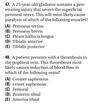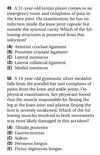[Review test] Lower Limb Flashcards
(31 cards)

- B
- C
- D
A 41 year old man was involved in a fight and felt weakness in extending the knee joint. On examniation, he was diagnosed with a lesion of the femoral nerve. Which of the following symptoms would be a result of this nerve damage
- A. Paralysis of the psoas muscle
- B. Loss of skin sansation on the lateral side of the foot
- C. Loss of skin sensation over the greater trochanter
- D. Paralysis of the Vastus lateralis
- E. Paralysis of the tensor fasciae latae
- D
The feomoral nerve innervates the quadratus femoris, sartorius, vastus lateralis

- 5 B
- innervates the chief evertors of the foot
- tibialis anterior (DPN)
- tibialis posterior
- triceps surae
- extensor hallucis longus (DPN)
- innervates the chief evertors of the foot
- 6 C

- 7 C
- 8 A
- innervates the peroneus longus and brevis
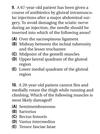
- 9 D
- 10 E
- Hamstring: Extend and thigh and flex leg
- sartorius : flex the thigh and leg
- vastus intermedius : extend the leg
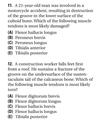
- 11 C
- flexor hallucis: groove on the posterior surface of the talus and the groove on the undersurface of the sustentaculum tali
- 12 D
A thoracic surgeon is going to colelct a portion of the greater sapheous vein for coronary bypass surgey. He has observed that this veins runs:
- A. posterior to the medial malleolus
- B. Into the popliteal vein
- C. Anterior to the medial condyles of the tibia and femur
- D. Superficial to the fascia lata of the thigh
- E. Along with the femoral artery
D

- 14 D
- 15 C
A 62 year old woman slips and falls on the bathroom floor. As a result, she has a posterior dislocation of the hip joint and a fracture of the neck of the femur

- 16 C
- The obturator artery gives rise to an acetabular branch that runs in the round ligament of the head of the femur
- 17 D
- D
If the acetabulum is fractured at its posterosuperior margin by doslocation of the hip bone, which of the following bones be involved?
- A. Pubis
- B. Ischium
- C.Ilium
- D. Sacrum
- E. Head of the femure
C
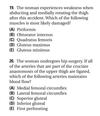
- 19 E
- 20 C
- The cruciate anastomoses
- inferior gluteal
- transverse branches of the medial and lateral femoral circumflex
- Ascending branch of the first perforating artery
- The cruciate anastomoses
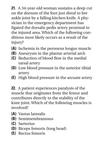
- 21 C
- 22 A
A patient is involved in a motorcycle wreck that results in avulsion of the skin over the anterolateral leg and ankle, which of the following is most likely destroyed woth this type of injury?
- A. deep peroneal
- B/ Extensor Digitorum Longus
- C. Dorsalis Pedis
- D. Great saphenou
- E. Superficial peroneal
E
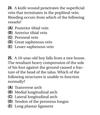
- 24 E
- 25 B
- Cuboid : keystone for the lateral longitudinal arch
- transverse arch
- navicular
- 3 cunefoirm
- cuboid
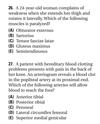
- 26 D
- 27 D

- 28 D
- Adductor canal
- femoral vessels
- sphaneous nerve
- nerve to the vastus medialis
- Adductor canal
- 29 C
- 30 D
- the gluteus maximus is inserted into the gluteal tuberosity
A 20 year old college student receives a severe blow on the inferolateral side of the left knee joint while playing football. Xray reveals a fracture of the head and neck of the fibula

- 31 C
- 32 C
A 20 year old college student receives a severe blow on the inferolateral side of the left knee joint while playing football. Xray reveals a fracture of the head and neck of the fibula
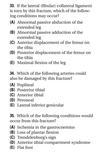
- 33 B
- 34 C
- 35 D
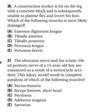
- 36 C
- 37 D
- Rectus femoris and Sarotius :femoral nerve
- Biceps femoris long head : Tibial portion of the sciatic nerve
- Bicep femoris short head : common peroneal portion of the sciatic nerve
- Pectineus: femoral and obturator nerves
A 24 year old woman presents to her physician with weakness in flexing the hip ajoing and extending the knee joint. Which muscle is most likely involved?
- A. Sartorius
- B. Gracilis
- C. Rectus femoris
- D. Vastus medialis
- E. Semimembranosus
C

- 39 C
- 40 B

- 41 A
- 42 D
A 35 year old man has diffculty in dorsiflexing the foot. Which of the following muscles is most likely damaged?
- A. Tibialis posterior
- B. Flexor digitorum longus
- C. Tibilias anterior
- D. Peroneus longus
- E. Peroneus Brevis
C

- 44 A
- 45 A
- 46 D
